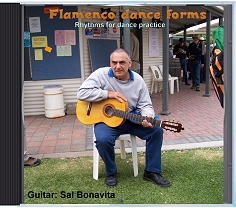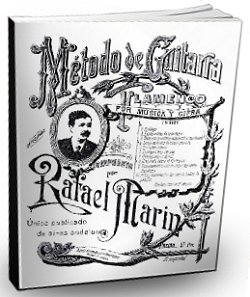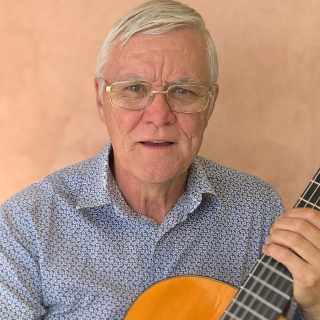
Alternating i and m picado restrokes.
The still photos
| Pic 1 | Shows the index finger about to strike the E string. The middle finger is actually resting on the B string. |
| Pic 2 | The index finger has just plucked the E string and is now resting on the B string. At the same time, the middle finger released itself from the B string and is now floating. But just for a split second. |
| Pic 3 | The index finger is still applying pressure on the B string as the middle finger flies immediately to rest on the E string. This stops the E string from ringing, giving a staccato effect. The action in images 1, 2 & 3 happened almost at the same time. In other words, as quickly as humanly possible. |
| Pic 4 | The middle finger has just struck the E string and is now resting on the B string. The index finger has just released itself from it's resting place on the B string and is floating. |
| Pic 5 | The index finger stops the E string. The action in images 4 & 5 happened in the blink of an eye. |
Sorry about the quality of the still pictures. The video shows these actions much clearer.
Practice tips
Don't flex the fingers too much
Picado is NOT the same as the classical guitar rest stroke. Once your finger makes contact with the string, you push it across to the next lower string with some force. The action is like a hammering a nail into a piece of wood. You are not lowering a baby gently into a cot. There will be some natural flexing of the first finger joint but the main focus is to get the finger to rest on the next string as quickly as possible and with as much volume as possible. So the point is not to consciously try to flex beyond what naturally happens during this action.
Practice slowly and RELAX the muscles between strokes
Come to a dead stop after each stroke and give yourself time to feel the fingers relax before continuing to the next stroke. Playing picado with tense fingers will never give you the speed and accuracy you want.
QUESTION: How can I learn to play fast if I practice slow?
ANSWER: You will have to trust me on this. I have tested this on myself and on students and I know it works. It's not magic. It's common sense. If it helps, just imagine that your practice time was strictly monitored by an ugly troll with a big stick who told you that if you played fast he would give you one. Just try it if you dare and let me know how you get on at the end of 30 days. For a more detailed explanation of the theory behind slow practice, please read my thoughts on finger robotics.
Don't straighten the fingers any more than you need to strike the string
Maintain the curve of the fingers as much as possible.
Keep the second knuckle joint close to the string being played
Keep the second knuckle joint from the fingertip of the playing finger as close as possible to the string being played. The viewing angle doesn't show this very well, but my second knuckle joint is actually lower than it looks on the video.
Cut the note short - play staccato
Staccato means to clip a sound so it has a very short duration. As soon as you play a note, get the next finger placed on the string as quickly as possible ready for the next note. Don't give it time to ring.
Always keep one finger on the strings
Think of it like walking. When you reach out to put one foot in front of you to take a step, the other foot does not leave the ground until the front foot is firmly on the ground. True or false? Unless you are a footloose puppet, there is no time when both feet are floating off the ground when you walk. Why should it be any different playing the guitar. The same principle applies when playing tremolo notes and arpeggios.
The principles above relate only to picado, tremolo and arpeggio
Of course there will be times in general playing when you DO want notes to ring and your fingers will be "floating" above the strings. As a general playing principle, the main issue is to keep the fingers as close as possible to the strings at all times, ready for anything. This principle is directly related to the accuracy, speed and strength of the sound. You don't necessarily have to play hard to get a clean, strong sound.
Practical video examples:
Viva espana (just a little demo with spurts of rapid picado)
Rumba (Lots of picado passages here and a picado run at the end)
Sevillanas (This is full of picado passages)
Guajiras (Passages of picado and runs)
Farruca (Passages of picado and runs)
Coconut woman (A picado run in the middle somewhere)





